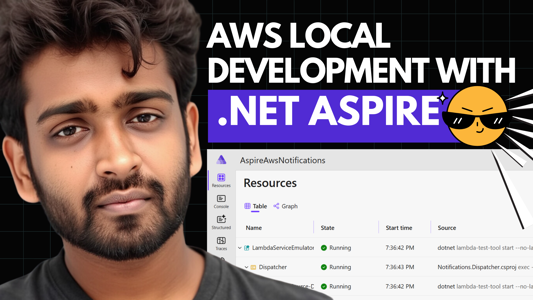.NET Aspire Tutorials
How to Deploy a .NET + React Full Stack App to Azure with Aspire 13
Today, we will take a complete .NET + React + Postgres + Keycloak application, and deploy the whole thing to Azure using Aspire 13.
Local DynamoDB Development with .NET Aspire and .NET 10 Minimal APIs (No AWS Account Required) - codewithmukesh
In this hands-on guide, we'll use .NET Aspire 13, DynamoDB Local, and .NET 10 minimal APIs to build a full CRUD Web API against DynamoDB—without ever touching an AWS account. Then we'll see how to flip a small configuration switch to point the same code to real DynamoDB in AWS.
AWS Local Development with .NET Aspire - Build a Serverless Notifications System - codewithmukesh
In this hands-on guide, we will use .NET Aspire 13 and the latest .NET 10 SDK to build a cloud-ready notifications system that talks to real AWS services like DynamoDB, SNS, and SQS, while keeping the entire local development experience orchestrated from a single Aspire app host.
🚀 AG-UI + Agent Framework + .NET + Aspire: Web-Enabling Your Intelligent Agents (Blog + Demo + Code!)
Today we’re diving into something very cool for .NET AI developers: 👉 How to expose your Agent Framework agents to the web using AG-UI 👉 How Aspire orchestrates everything for you 👉 And how this makes building multi-client, AI-powered experiences ridiculously easier
Part 3: From Neural Networks to Autonomous Coffee Roasting - Orchestrating MCP Servers with .NET Aspire 13 and n8n Agents
Can .NET Aspire orchestrate Python MCP servers and n8n workflows to autonomously roast coffee? Spoiler alert: Yes, it can. And the coffee tastes spot on.
Taming Service Dependencies with Aspire
Tired of wrestling with local development environments? You're not alone. Setting up and maintaining local services—especially a mix of cloud-native and legacy apps—is a common headache for developers. We're packaging our applications as Aspire integrations. In this talk, we'll walk you through our journey and show you how extending Aspire is transforming our development workflow.
Windows 365 Meets Aspire - Supercharging Multi-Repo Microservice Productivity
This session explains how Windows 365 global engineering teams utilizes Aspire to support multi-repository microservices development with F5 experience (Clone, Build, and F5 Innovate). It introduces the AddMicroservice extension, which helps onboard and integrate microservices across different repositories with Aspire, and the RunAsEmulator extension for loading dependencies from microservice containers or emulators.
From Architecture to Docs: .NET Aspire Documented with Copilot
Tired of your architecture diagrams becoming outdated before they even reach production? In this hands-on session (Level 300), you’ll learn how to turn .NET Aspire AppHost definitions into living documentation —Mermaid diagrams, markdown, and Aspire Dashboard screenshots— powered by GitHub Copilot Chat and the Copilot Coding Agent.
Taking .NET out of .NET Aspire - working with non-.NET applications
This talk explores how Aspire can work with applications and services not written in .NET. Learn how to add Aspire to your applications regardless of the programming model used, and benefit from the features (including the real-time developer dashboard) that Aspire offers.
Aspire Unplugged with David and Maddy
Join an engaging conversation with David Fowler, the architect behind Aspire, as he shares insights into the vision, design decisions, and future direction of this transformative framework. Learn about the problems .NET Aspire was designed to solve, hear stories from the development process, and get answers to the community's most pressing questions.










